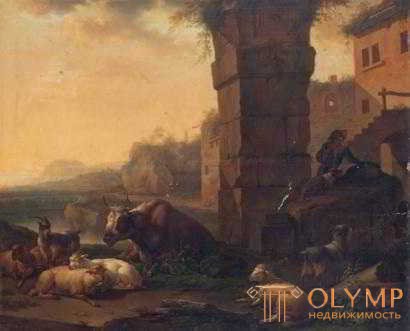
1. Overview of the development of Belgian painting
During the XVIII century, Belgian painting finally lost in the struggle for influence in Europe. However, in the direction of genre and landscape painting can be identified a number of major masters.
The number of painters in Belgium in the XVIII century was, perhaps, greater than in any other country. The Belgian art of this century, however, with a few exceptions, which we will now become acquainted with, shredded almost completely. Both in terms of content and technology, she continued to use old formulas, recipes and traditions. Of the masses of Belgian painters who continued to follow the Rubens tradition, stand out Peter Joseph Verhagen (1728–1811) and Willem Jacob Gerreins (1743–1827) Verhagen, court painter Maria Theresa, although he worked mostly in Leuven, sought to get closer to Rubens; nevertheless, his forms involuntarily receive cold contours, his writing is superficially flattened, and the coloring is a rigid variegation of a new, fashionable direction. It is necessary to name his Great Meeting in the temple (1767) of the Ghent Museum, sv. Stephen accepting the papal embassy (1770), the Viennese gallery and the “Exile of Hagar” in the Antwerp Museum. Gerreins was the court painter of the Swedish king Gustav III and at the same time the director of the Antwerp Academy of Arts. Also in his paintings one can still feel the Rubens line and Rubens color. The Antwerp Museum, in addition to a few portraits of his hand, owns the great Crucifixion, and the Brussels Museum has a solid Adoration of the Magi. The colder “Journey to Emmaus”, in the Antwerp Cathedral, appeared only in 1808.
Epigones of the Flemish genre painting, such as Balthazar van den Bose (1681–1715), Jan Joseph Goremans the Elder (1682–1759) and his son of the same name (born in 1714, died after 1790), and watery landscape and battle painters like Theobald Michaux (1676–1765), Karel Braydel (1678–1733), Frans Braydel (1679–1750), Karel van Falens (1683–1753) and Peter Jan van Regemter (1755–1830) do not deserve special attention . Landscape painter Jean Baptiste Juppin from Namur (1678–1729), an imitator of Dughet, who adorned, among other things, the biblical landscapes of the church of St. Martina in Luttich, could perhaps arouse some interest, as one of the last representatives of the Belgian church landscape painting.
The turn to classicism is reflected only in one Belgian historical painter of the 18th century, the turn in nature is mainly reflected in one landscape painter and the painter of animals. The historical painter, Andreas Konpelis Lene of Antwerp (1739–1822), was the court painter to Prince Carl of Lorraine and professor at the Antwerp Academy. In Rome, in the circles of Winckelmann and Mengs, he became a fanatical supporter of the doctrine of the imitation of the Hellenes; returning to his homeland, he promoted both his paintings and theoretical works to a new, false classic, and in his eyes, of course, a classic style. He was one of the first, most stringent new scammers. Of his cold in form, poor in color, completely non-Flemish paintings can be called the "Annunciation" in the church of St. Michael in Ghent, "Ariadne" and "Feast of Bacchus" in the Brussels Museum. They vaguely resemble Poussin.

Fig. 245. Pasture. Painting by Balthazar Pauwel Ommegank in the Braunschweig Museum.
Landscape painter and animal painter, returning to nature - Balthazar Pauvel Ommegank (1755–1826), Paul Potter of his time. Surprisingly directly and freshly observing the life of domestic animals, for the most part among the brightly lit sun of the landscape, he was able to transform his visual impressions into finished, spectacular pictures, among which the main role is played by images of sheep herds. We get acquainted with the works of this artist in the Louvre, in the Antwerp, Amsterdam, Rotterdam, Brunswick and Leipzig museums. True, his letter is rather dry, he carefully writes out all the details, every shred of fleece, and yet their overall impression is often amazing. Ommeganka paintings undoubtedly mark a step forward in the observation and transmission of nature, and in this sense it belongs to the pioneers of the art of the XIX century.
Что бы оставить комментарий войдите
Комментарии (0)